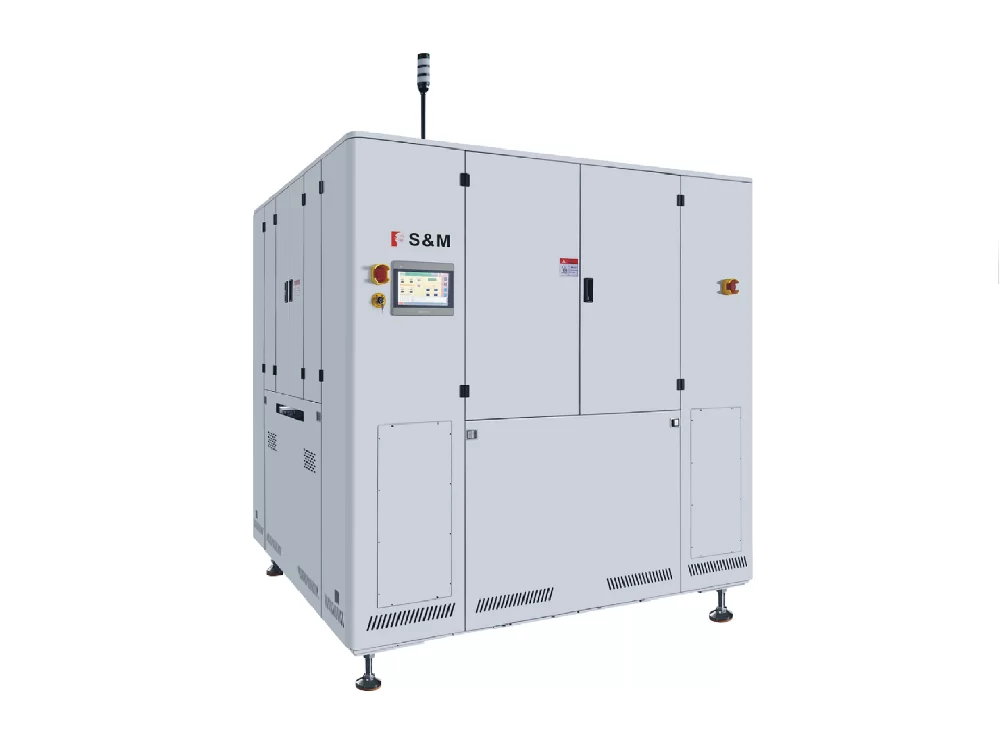
Overview
Vertical curing ovens are primarily located in the later stages of the SMT process, where they are used for drying or curing after dispensing or coating. They are suitable for drying or curing underfill adhesives and conformal coatings (including conformal coatings) after dispensing or coating. The operating temperature range is typically room temperature to 180℃, and the drying or curing time is typically 10 to 120 minutes, which can be adjusted according to the specific adhesive requirements. If the factory’s production capacity demand is too large but the required drying or curing time is too long, resulting in a mismatch or conflict, it is recommended to adopt a 1-to-N wiring configuration, where one dispensing or coating production line is equipped with multiple vertical ovens.
Vertical curing oven VS Horizontal curing oven/Offline curing oven
1) Significantly Reduced Labor Costs – Compared to offline curing ovens, this machine features fully automatic board loading and unloading, eliminating the need for manual handling of products in offline curing ovens.
2) Improved Curing Quality – Compared to offline curing ovens, the elimination of manual opening and closing of the oven body results in more stable internal temperatures and superior product quality;
3) Significantly Reduced Footprint – Compared to horizontal curing ovens (or conventional SMT reflow ovens), vertical ovens require several times or even tens of times less footprint for the same production capacity;
4) Improved Energy Efficiency – Compared to horizontal curing ovens (or conventional SMT reflow ovens), it fully utilizes the principle of upward movement of hot air, resulting in more efficient use of thermal energy.
Main Specifications
| Project | Parameter | |
| 一 | Key technical parameters of the structure and transmission | |
| 1 | Overall machine dimensions (L*W*H) (mm) | 2350*1670*2050(Subject to model) |
| 2 | Number of heating zones | Front 4 zones, Back 4 zones |
| 3 | Heat source method | hot air |
| 4 | Furnace in-furnace transmission method | 25.4mm pitch chain + stepper lift |
| 5 | Track width adjustment method | Automatic width adjustment step |
| 6 | Storage plate structure | Dual-stage independent drive design, 25 layers per stage |
| 7 | Flow direction | From left to right |
| 二 | Key technical parameters of the process | |
| 1 | Furnace chamber memory board width | 50-300mm(L:330) |
| 2 | Overboard edge | 3mm |
| 3 | In/out plate height | 900±20mm |
| 4 | Temperature control range | Room temperature -200℃ |
| 5 | Temperature control accuracy | ±1℃ |
| 6 | Cycle time | ≥12Sec |
| 7 | Single cycle | ≥9min |
| 三 | Key technical parameters of the control system | |
| 1 | Overall machine control method | Touch screen + PLC + fiber optic |
| 2 | Heating method | PID+SSR |
| 3 | Wind control method | Variable frequency drive + three-phase motor, a total of 4 variable frequency drives |
| 4 | Alarm methods | Human-computer interaction + sound and light alarm |
| 5 | Power failure protection | UPS power supply protection |
| 6 | Software operation | Features 3-level access control and 50 recipe sets. |
| 7 | Electrical requirements | Three-phase AC380V±15%, 3P+1N+1E |
| 8 | Power supply | 40KW |
| 9 | Starting power | 40KW |
| 10 | Normal power | 11KW |
| 四 | Key technical parameters of information systems | |
| 1 | Front and rear connection method | SMEMA |
| 2 | MES system | Reserved RS232 interface for expansion with TCP/IP protocol |
Equipment Routine Maintenance
To ensure the efficient use of production equipment and its effective service, customers must develop a specific equipment maintenance plan and assign dedicated personnel to perform maintenance on each piece of equipment according to the plan, meeting the following requirements. Corresponding maintenance records should also be completed. It is recommended to combine the maintenance plan and records into a single monthly table; a sample equipment maintenance checklist is provided below.
To ensure the safety of equipment operators and maintenance personnel, repair work should be performed at room temperature whenever possible, and all maintenance work must be carried out at room temperature.
Routine Maintenance Requirements
1. Remove external debris from the machine; wipe away dust with a cloth.
2. After the machine has cooled down, open the inlet and outlet doors and clean the interior of the machine of debris and dust.
3. Check all transmission parts for loose screws; tighten any loose screws.
4. Clean and lubricate all transmission pairs (such as adjusting worm gears, worms, push plate mechanisms, sprockets, chains, lifting sprockets, chains, etc.). The lubricant must be heat-resistant.
5. Inspect and clean the surfaces of all sensors (such as optical fibers), paying particular attention to the sensing surfaces, which require wiping and cleaning.
